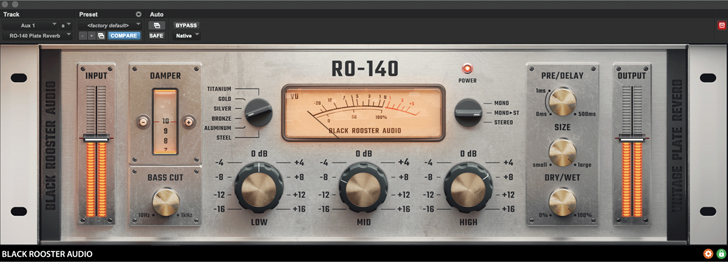|
|
Black Rooster Audio RO-140 Plate Reverb Plugin
|
|
|
 |
| Black Rooster Audio RO-140 Plate Reverb |
Black Rooster's very first reverb plugin is a model/recreation of the classic EMT 140ST Plate that originally cost $7,000 in 1957 for the first mono only version. An electromechanical reverberation device, the EMT was a 4 X 8-foot long and 16-inches deep pressboard box that housed a suspended and very heavy molybdenum steel plate.
The whole system used tube amplifiers and weighed 425 pounds. There was a driver much like a speaker voice coil and magnet assembly that vibrated the plate and then one or more pickups attached to the plate in different locations picked up the vibrations.
In the 50s and '60s, small studios (especially in cities) started using plate reverbs because they didn't have the space to build a proper sized echo chamber. Plate reverbs can vary drastically in sound. Back in the day, there were a few that sounded magical and most sounded OK. They require electronic maintenance, and expert tensioning and tuning of the suspended sheet metal inside.
The RO-140 is modeled on the EMT but has something totally new: a choice of six different plate materials: gold, silver, bronze, aluminum, titanium, and steel. I liked that there is a selector switch right on the GUI to select between any of them. Changing the plate's metal is interesting; this is all new and I'm getting use to this parameter as good way to customized a reverb sound and save it as a preset! Six different metal choices is a remarkable idea and never conceived of back in the day.
Another all new feature is the ability to control the physical size of the plate from Small to Large using the Dynamic Plate Size Controller. The RT60 or the decay time on the RO-140 is adjusted using the Damper +/- buttons.
Just like the original EMT plate, the damper is a large sheet of stiff, cloth-like material (originally it was asbestos) mounted right next to the vibrating plate. Varying its distance from the plate determines the decay time. The old plates had a metal wheel sticking out of the top that cranked the damper closer or further away from the plate.
Later, a remotely controlled motor replaced the wheel so you could change the damper (RT60) while listening back in the control room. Also like the original hardware, there is a lighted edge-wise meter on the RO-140's GUI to indicate decay time in seconds as you changed the damper.
Other controls are: Pre-Delay of up to 500ms delay time before the plate actually starts vibrating; I find pre-delay useful for orchestral string sections and brass. RO-140 also adds the ability to gain stage both the input and output of the reverb with large faders, an adjustable high pass filter (10Hz to 1kHz). A Dry/Wet control is also provided if you use it as an insert, otherwise you would keep this control at 100% wet if you send and return to it.
I discovered the true nature of RO-140 when dialing in a reverb for lead and backing vocals in my mixing. I liked that you may set the reverb to be in mono like the 1957 original so the reverb is directly behind and mixed in with the singer's voice and not spread out left and right.
You can also set it to full stereo as the later model plates used two (L/R) transducers to pickup the vibrating plate. When sending and returning reverb, my preference is to use the mono-to-stereo mode where a mono send signal returns a stereo reverb.
By nature, plate reverbs are a bright sound but you can use the three-band equalizer to shape its sound anyway you want. I like using this broad EQ when using RO-140 as an inserted effect. Inserted on electric guitar tracks, the EQ and plate reverb act together as a mixing and mastering finishing touch.
A good plugin to have in your collection, Black Rooster RO-140 runs Native in AAX, VST, AU hosts and sells for $69.99 in a special introductory sale. It runs on Macs OS 10.9 or newer (but not Big Sur) and on PCs Windows 7 or newer.
blackroosteraudio.com/en/landing/ro-140
|
|
|